With a joint declaration held on Friday, January 27, 2022, the President of the European Commission (EC) and the President of the United States responded to Russia’s threats on Ukraine’s borders by reinforcing their energy alliance to guarantee a “continuous, sufficient and opportune” supply of gas to the community bloc in the event of a crisis, such as a possible attack by Moscow on Kiev.
The problem with the EU is that it relies heavily on gas imports from Russia, which brings together 41% of them. Diversifying its portfolio and reducing dependence on Russian gas is one of the great objectives that the EU has set for itself for a long time. Washington is currently the largest supplier of liquefied natural gas (LNG) to the EU, a fuel that in the short term can reinforce the security of supply and at the same time allow the transition to zero emissions.
Production and consumption in the United States and the EU
The figures for natural gas (NG) are stunning due to their magnitude. The average proven reserves of the world is estimated at 198.8 billion m³. Translated into potential reserves, are close to 400 trillion m³ (Figure 1).
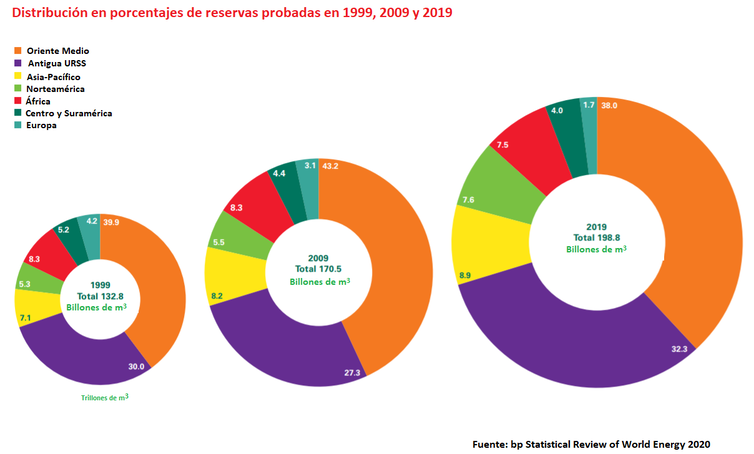
Review of World Energy 2020, BP
In 2019, last year with consolidated data, 3,989 Mm³ (Mm³ = billion m³) were produced in the world. The largest producer was the United States (921 Mm³; 23% of world production), six points more than Russia (17%). The Americans consumed 846 Mm³ that year and left the surplus (75 Mm³) for export (figure 2).
This extraordinarily high domestic consumption is due to the fact that the excess supply of the US gas industry causes consumers to pay prices well below the world average that have threatened to the collapse of the industry if exports do not increase and domestic supply decreases. This also explains why, due to the impossibility of using it, every year in the United States the highly polluting torches they burn in their own deposits some 140 Mm³ of natural gasand why US gas producers have been in danger of dying of success.
If we combine surpluses and gas burned in fields, the United States could export more than 200 Mm³ each year, a disproportionate volume that, to put it in context, represents almost six times the consumption of Spain in 2019 (36 Mm³). It is an export that, I insist, the United States could increase by turning off the tap on domestic supply a little.
For its part, the EU produces 63.3 Mm³ each year, and consumes 395.9, which means that each year the demand for natural gas exceeds domestic production by 295 Mm³ and represents a bill of some 40 billion dollars, 23% of the cost of its total energy imports. 60% of that demand could theoretically be covered with imports from the United States.
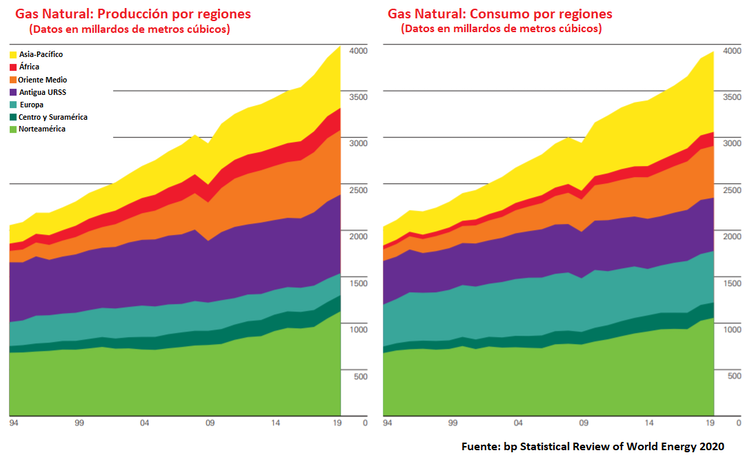
Review of World Energy 2020, BP
Even if the volume imported from the United States were necessarily smaller (there are other countries, especially Asian ones, that depend on imports from that country), the EU would have no difficulty in completing US imports with its current suppliers, excluding Russia (43 % of European imports) and promoting other sources, especially from Mediterranean basin countries whose productive potential greatly exceeds demand.
For their part, the United States would be delighted. They look to Europe as one of their preferred clients as the profitability of gas shipments is higher than that reported by other markets. The cash return is $52.53 per million british thermal units in the case of Europe while for Asia it is around 43.8 dollars.
pipelines
It was in China, around the year 900 before our era, when natural gas began miles away using mud-sealed bamboo pipes. Nearly three thousand years later, the world’s first modern gas pipeline opened in Argentina in 1949.
As gas pipelines began to be perfected, a dense network was laid mainly on a continental scale (but also intercontinental in the case of continents separated by relatively short distances, such as North Africa and southern Europe) and natural gas became occupy an increasingly relevant portion of the world energy supply (figure 3).
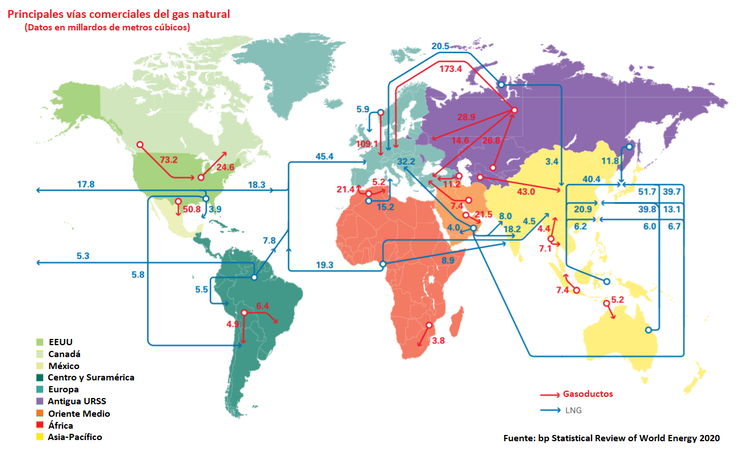
bp Statistical Review of World Energy 2020.
Some nineteenth-century inventions
Commercial gas traffic was restricted for a long time to transportation by pipeline, which left isolated the gas extracted in other regions far away from consumption centers or surrounded by seas. Things would change in the 19th century thanks to the laws formulated before and during a time in which the world witnessed unprecedented scientific production.
The experimental gas lawa law that combines those of Robert Boyle (1627-1691), Jacques-Charles (1746-1823) and Joseph-Louis Gay-Lussac (1778-1850), came to demonstrate the relationships of pressure, volume and temperature with the state of gases. He now had to go from theory to practice. That is precisely the task he absorbed into Michael Faraday (1791-1867).
In 1823, Faraday became interested in the possibility of gas liquefaction, a matter that was far from clear, and he undertook a series of experiments that constitute the first systematic attempt to investigate the question. His conclusions showed that, at atmospheric pressure, when natural gas is cooled to -161 ℃ it becomes a liquid and can be handled as such.
In 1895 the German inventor Karl von Linde (1842-1934) succeeded in liquefying air by first compressing it and then letting it expand rapidly, cooling it.
In 1870 Linde built the absorption machine, that is, the refrigerator (figure 4). To liquefy air, he used a method based on the work of two other Noucentista physicists, James Prescott Joule (1818-1889) and William Thomson (1824-1907), and the introduction of the countercurrent technique.
The air is sucked into the machine, where it is compressed before it cools down and is then decompressed, at which point it cools down. In the heat exchanger counterflow, the already cooled air is used to further cool the compressed air, which is cooled again with the next air intake. The continuous repetition of the process leads to a further reduction in temperature until the air liquefies.
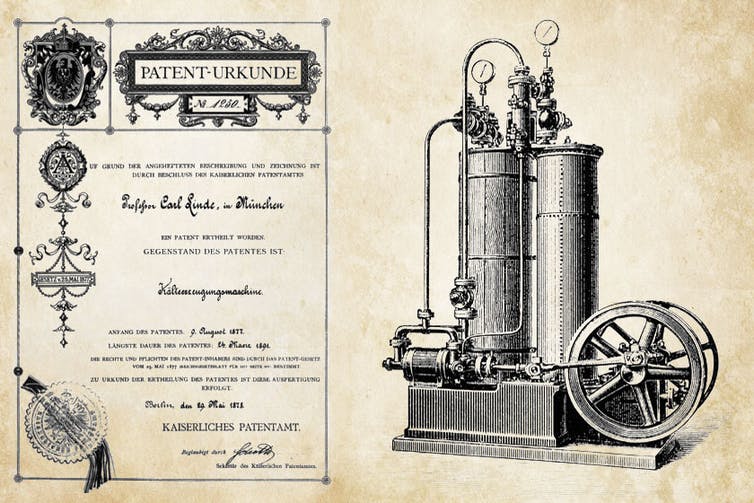
Linden Group
methane tankers
When natural gas is pressurized to its liquefaction temperature and transformed into liquefied natural gas, it occupies approximately 600 times less volume than in the gas phase. This allows its transport and storage in tankers, also called methane tankersbecause natural gas is essentially just that, methane.
A medium-sized methane tanker with a capacity of 100,000 m³ can carry 60 million m³ of LNG. To put things in perspective, some 36 Mm³ of natural gas are consumed annually in Spain, which means that 600 voyages of one of these vessels would be required to supply our annual consumption.
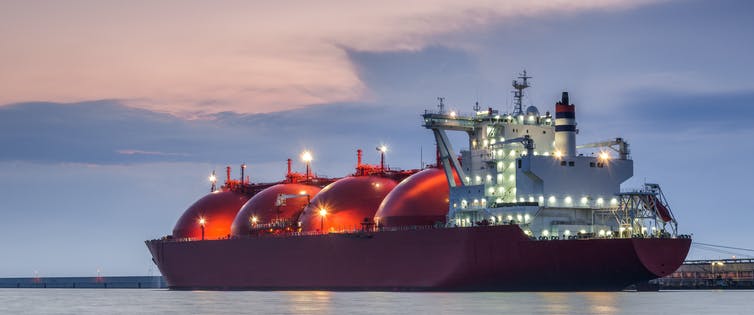
Shutterstock / Wojciech Wrzesien
Liquefied natural gas is an alternative to transporting natural gas through pipelines. As the distance over which the gas must be transported increases, the economic advantages of the pipeline over LNG decrease. The capital and operating costs of the gas pipeline grow exponentially with its length, while a liquefied natural gas system has only one variable component with distance: maritime transport, traditionally much cheaper per mc transported.
For this reason, it is accepted that for distances over 1,000 kilometers and flow rates greater than 15 million m³ per day, LNG is competitive with gas pipelines. However, this general statement does not take into account additional costs such as crossing rivers, mountains, forests, etc., in the case of gas pipelines. Nor the need to build ships and expensive port facilities in the case of liquefied natural gas terminals.
LNG projects are technically very complex, require long construction times and require several billion euros of investment. An investment that Spain has amortized, because it has six active regasification plants with a receiving capacity of 60 Mm³, which represents 36.5% of Europe’s regasification capacity. In fact, in the last month of 2021, 31.2% of the gas imported into Spain was made through a gas pipeline and the remaining 68.8% as LNGwhich includes energy partners as far afield as Australia.
John Fitzgerald Kennedy said that the Chinese use two strokes to write the word crisis. One stroke means danger, the other opportunity. According to Kennedy, in a crisis you have to be aware of the danger, but also recognize the opportunity. In the current Ukraine crisis, the United States has found an opportunity to place its colossal natural gas surpluses in Europe. In Spain, Enagás, the main manager of the regasification stations, is rubbing its hands.
Manuel Hairstyle Lorca, University Professor. Director of the Royal Botanical Garden of the University of Alcalá., University of Alcala
This article was originally published on The Conversation. read the original.